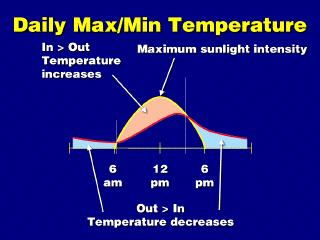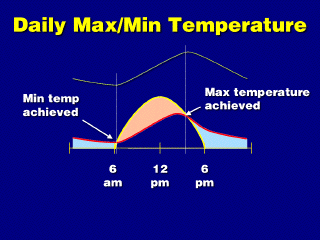 The reason that the daily maximum temperature occurs later than noontime is
due to a delay between the max in the incoming sunlight intensity (yellow line)
and the max in the outgoing
terrestrial IR radiation rate (red line). This diagram shows that the outgoing
radiation peak is only a little bit after the insolation peak, but it's significant.
Also note that the outgoing radiation is never zero, since any object with a
temperature above absolute zero (0 Kelvin) will radiate (Stefan-Boltzmann
Law).
The reason that the daily maximum temperature occurs later than noontime is
due to a delay between the max in the incoming sunlight intensity (yellow line)
and the max in the outgoing
terrestrial IR radiation rate (red line). This diagram shows that the outgoing
radiation peak is only a little bit after the insolation peak, but it's significant.
Also note that the outgoing radiation is never zero, since any object with a
temperature above absolute zero (0 Kelvin) will radiate (Stefan-Boltzmann
Law).
We recall that if the amount of radiation
absorbed by an object is not equal to the amount emitted away, the temperature
will change (see radiative
equilibrium). Between a time shortly after sunrise at 6 am and a time in
the middle of the afternoon, incoming sunlight intensity exceeds outgoing
radiation rate, so temperatures increase. Temperatures increase until this
relationship reverses in the middle of the afternoon, when the outgoing radiation
rate begins to exceed the incoming sunlight intensity. This marks the time of
the maximum temperature. From this point until a time just after sunrise, the
outgoing radiation rate exceeds incoming sunlight intensity, so temperatures
decrease. The minimum temperature is then reached at that time shortly after
sunrise.
 Note that the points where the max and min temperature occur are when
the incoming and outgoing curves intersect, because that's when the relationship
between the incoming and outgoing radiation reverses.
Note that the points where the max and min temperature occur are when
the incoming and outgoing curves intersect, because that's when the relationship
between the incoming and outgoing radiation reverses.



 The reason that the daily maximum temperature occurs later than noontime is
due to a delay between the max in the incoming sunlight intensity (yellow line)
and the max in the outgoing
terrestrial IR radiation rate (red line). This diagram shows that the outgoing
radiation peak is only a little bit after the insolation peak, but it's significant.
Also note that the outgoing radiation is never zero, since any object with a
temperature above absolute zero (0 Kelvin) will radiate (Stefan-Boltzmann
Law).
The reason that the daily maximum temperature occurs later than noontime is
due to a delay between the max in the incoming sunlight intensity (yellow line)
and the max in the outgoing
terrestrial IR radiation rate (red line). This diagram shows that the outgoing
radiation peak is only a little bit after the insolation peak, but it's significant.
Also note that the outgoing radiation is never zero, since any object with a
temperature above absolute zero (0 Kelvin) will radiate (Stefan-Boltzmann
Law). Note that the points where the max and min temperature occur are when
the incoming and outgoing curves intersect, because that's when the relationship
between the incoming and outgoing radiation reverses.
Note that the points where the max and min temperature occur are when
the incoming and outgoing curves intersect, because that's when the relationship
between the incoming and outgoing radiation reverses.